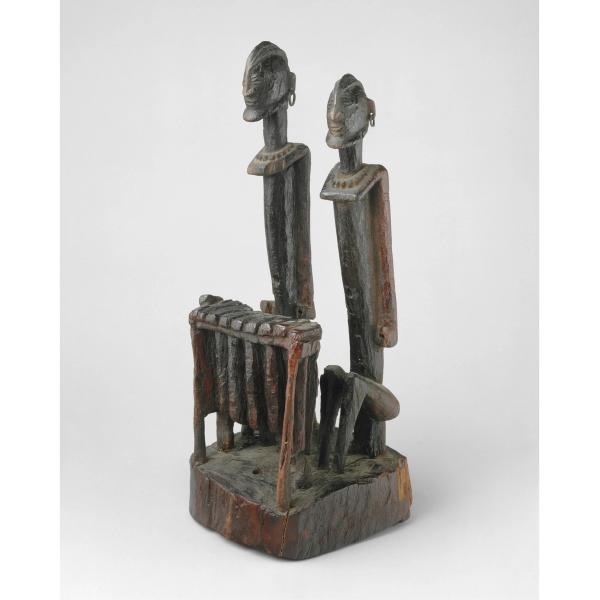Pair of bala players
The work may also refer to a series of events related in the epic narratives surrounding the formation of the Mali empire (ca. 1230), many of whose inhabitants migrated to villages such as Mételli in subsequent centuries. According to these oral histories, a balafon player had a central role in the defeat of the Soso kingdom and its invincible ruler Soumaworo. In a ruse, Mali's ruler Sundiata Keita sent his sister Sologon and the court musician Bala Fasséké Kouyaté to Soso as spies to discover the source of Soumaworo's power. Through Sologon's beauty and Kouyaté's masterful balafon playing, they learned Soumaworo's secret and Keita defeated him on the battlefield. Keita rewarded Kouyaté with the captured royal balafon of Soso. Given that balafons are typically played by one individual, the association of two figures with this instrument may be a reference to Sologon and Bala Fasséké Kouyaté, and their important contribution to the region's history.
Artwork Details
- Title:Pair of bala players
- Artist:Dogon blacksmith
- Date:18th–early 19th century
- Geography:Mali, Bandiagara Escarpment, Mételli village
- Culture:Dogon
- Medium:Wood, metal, applied organic materials
- Dimensions:H. 15 7/16 x W. 5 3/4 x D. 6 1/2 in. (39.3 x 14.6 x 16.5 cm)
- Classification:Wood-Sculpture
- Credit Line:The Michael C. Rockefeller Memorial Collection, Bequest of Nelson A. Rockefeller, 1979
- Object Number:1979.206.131
- Curatorial Department: The Michael C. Rockefeller Wing
Audio

1532. Pair of bala players, Dogon blacksmith
Baaba Maal
[BALAFON PLAYING]
BAABA MAAL: Whatever you say, wherever you go, in the tradition of all the people of Africa, especially West Africa, the music is always here.
My name is Baaba Maal. I’m a musician from Senegal.
When you come into this exhibition, you’ll see this piece of two people up in front of a balafon. You are coming to West Africa where you can find all these great empires, these great kingdoms, and these great communities that are always just sitting under tree in the middle of the village, and they play music and they talk, they exchange ideas. And the young people are there just to learn the legacy from the old generations.
ANGELIQUE KIDJO (NARRATOR): In this depiction of a pair of musicians, the instrument they play is a balafon, which is a kind of xylophone. There are wooden slats to strike and hollow gourds below to amplify the sound.
[BALAFON PLAYING]
BAABA MAAL: It’s very mystical, you know. You can hear a human being playing it, but behind this human being, it’s like a spirit is playing to you. It’s helping you to travel into your history, into your own personality, and to discover who really you are according to who are your ancestors, and this is something I really appreciate in these instruments. If you don't know where you come from, you will never know who you are. And if you don't know who you are, you will not be able to live in harmony in your country with all these people, because it’s a community.
More Artwork
Research Resources
The Met provides unparalleled resources for research and welcomes an international community of students and scholars. The Met's Open Access API is where creators and researchers can connect to the The Met collection. Open Access data and public domain images are available for unrestricted commercial and noncommercial use without permission or fee.
To request images under copyright and other restrictions, please use this Image Request form.
Feedback
We continue to research and examine historical and cultural context for objects in The Met collection. If you have comments or questions about this object record, please contact us using the form below. The Museum looks forward to receiving your comments.
